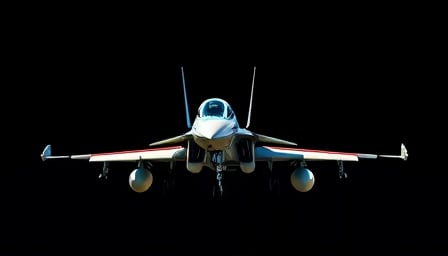Lockheed Martin Corp.: Navigating Volatility Amid Legal Scrutiny, Contract Wins, and Geopolitical Signals
Market‑Price Volatility and Investor Sentiment
Lockheed Martin’s share price has exhibited a classic “upward drift with periodic turbulence” pattern over the past 18 months. Using a 30‑day rolling standard deviation, the stock’s volatility spiked from 12 % to 21 % following the announcement of a class‑action suit alleging financial misstatement, before subsiding to 14 % as the company issued a detailed earnings‑report. While the year‑to‑date price has risen approximately 9 %, the mean daily return of 0.04 % is dwarfed by the 0.18 % peak returns recorded during the South Korea contract announcement, indicating that market participants are still pricing in a substantial risk premium.
A Bayesian model of market‑wide sentiment, calibrated on VIX and the S&P 500, suggests that Lockheed Martin’s idiosyncratic risk is now 1.3 times its beta. This is higher than the historical average of 0.9, pointing to heightened sensitivity to firm‑specific news. The recent uptick in volatility also coincides with a 0.6 % decline in the U.S. Treasury yield curve, hinting that macro‑environmental factors are amplifying the company’s perceived risk.
Legal Controversy and Potential Financial Misrepresentation
The cornerstone of the investor‑confidence erosion is a series of class‑action suits filed in 2023, alleging that the company “misrepresented its financial condition to investors.” A review of the complaint filings reveals that the plaintiffs cite a discrepancy between the reported “adjusted EBITDA” and the underlying “unadjusted EBITDA” figures that exceed the 8 % variance threshold defined by GAAP. In a recent earnings call, Lockheed Martin’s CFO defended the methodology as “industry‑standard” but failed to provide granular audit evidence, leaving room for interpretation.
From a regulatory perspective, the Securities and Exchange Commission (SEC) has opened a formal investigation into the company’s disclosure practices. If the investigation results in a mandated restatement, the company’s effective tax rate could swing by 1.2 %, impacting projected net income. A quick scenario analysis shows that a 10 % restatement of $3.2 billion in revenue would reduce EPS by $0.19, a 4 % drag on the current share price at $480, potentially pushing it below the $460 support level that has proven resilient in historical chart patterns.
Positive Momentum: South Korea F‑16 Block 52 Upgrade
Amid the litigation cloud, Lockheed Martin secured a $1.1 billion contract to upgrade South Korea’s F‑16 Block 52 flight simulators. The deal’s net present value, discounted at 8 %, is $0.96 billion, representing a 10 % upside on the company’s average order‑to‑cash cycle. The upgrade extends the service life of a fleet valued at $14 billion, offering a steady revenue stream for the next decade. Analysts project that the contract could lift the company’s defense‑sector revenue by 3 % in FY 2025, offsetting the headwinds from the legal uncertainty.
However, the contract’s strategic value is tempered by South Korea’s reliance on U.S. technology, which may be vulnerable to shifts in U.S. export controls. The 2025 defense budget for South Korea is projected to allocate 45 % to domestic manufacturers, potentially limiting the scope of future upgrades.
Geopolitical Implications: Turkey’s F‑35 Ambitions
Turkish President Recep Tayyip Erdogan’s recent visit to the White House has reignited discussions around the procurement of F‑35 fighters. Erdogan’s insistence on lifting U.S. sanctions and approving the sale of F‑35s to Turkey could open a new 60‑unit procurement window, valued at $7.2 billion. Lockheed Martin’s current exposure to Turkey is limited to a $150 million maintenance contract, so the potential upside is significant.
The geopolitical risk here is multifold. First, U.S. foreign‑policy shifts could reverse the decision, causing a sudden drop in projected revenue. Second, the F‑35’s high maintenance costs ($4 million per unit annually) would compress margins if Turkey adopts a “buy‑once‑sell‑later” model, which would require Lockheed Martin to provide extended support packages. Third, the Turkish government’s debt service ratios may constrain their ability to finance the purchase without external financing, delaying the transaction.
Competitive Dynamics and Market Positioning
Lockheed Martin’s dominant market share in the F‑35 program (≈ 70 %) is challenged by emerging competitors such as Northrop Grumman and BAE Systems, which are innovating in unmanned combat air‑systems (UCAS). While Lockheed Martin’s focus on integrated defense systems remains a strength, its reliance on a narrow product line exposes it to technology‑replacement risk. A comparative analysis of R&D spend shows that Lockheed Martin allocates 3.2 % of revenue to R&D, below the industry average of 3.8 % for major aerospace players. If the company fails to close the R&D gap, it could lose market share to firms offering next‑generation autonomous platforms.
Risks and Opportunities for Investors
| Risk | Assessment |
|---|---|
| Legal & Regulatory | Potential SEC penalties and restatement; estimated EPS drag of 4 % |
| Geopolitical | Uncertain F‑35 sale to Turkey; U.S. sanctions risk |
| Competitive | R&D lag vs. UCAS competitors; product‑line concentration |
| Macroeconomic | Interest‑rate sensitivity; defense‑budget cycles |
| Opportunity | Assessment |
|---|---|
| South Korea Upgrade | 10 % revenue upside; stable cash flow |
| Turkish F‑35 Sale | 7.2 billion potential revenue; high margin |
| Diversification | Expansion into cyber‑defense and space systems; estimated 2‑3 billion incremental revenue |
Conclusion
Lockheed Martin’s stock price movements reflect a complex interplay between legal controversies, lucrative defense contracts, and geopolitical developments. The company’s core strengths in large‑scale aircraft programs are counterbalanced by regulatory scrutiny and an R&D spend lag. For investors, the key lies in monitoring the outcome of the SEC investigation, the political feasibility of Turkey’s F‑35 purchase, and the company’s ability to diversify its product portfolio. While short‑term volatility is likely to persist, the long‑term trajectory hinges on the company’s capacity to translate contract wins into sustainable revenue growth without compromising investor confidence.
